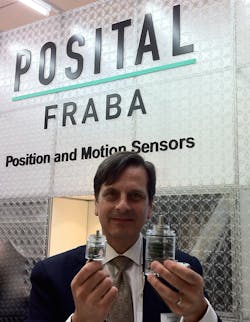The Amazon.com-Magnetic Encoder Connection
Even though optical absolute encoders represent the bulk of sales for Posital, a division of the industrial group Fraba, its CEO, Christian Leeser, believes that magnetic sensor encoders will one day replace the use of optical sensor encoders. And he is pushing to make that day come as soon as possible.
Speaking with Leeser at the Posital Farba booth at Hannover Fair 2014, Leeser told me that Posital’s development of a proprietary algorithm has enabled the company to “enhance the performance level of magnetic sensor encoders by 4-8 times. This algorithm operates much like a Big Data analytics processor to improve the encoder technology by parsing through the mounds of information” sensed by the encoder, he said.
He adds that these improvements have been made possible by the increasing capability and decreasing size of microprocessors driven by Moore’s Law. Using a quad core, 32-bit microprocessor, Posital’s Ixarc magnetic sensor encoders reportedly provide an accuracy of 12 bits at a 16-bit resolution. Plus the new Ixarc encoders are much smaller than optical encoders (see picture of Leeser holding up examples at Hannover Fair) and they employ energy harvesting.
According to Posital, Ixarc encoders—which are based on Hall sensors and generate analog output signals—register motor revolutions using an energy harvesting system based on the Wiegand effect, in which power is derived from the rotating magnetic field.
Ixarc encoders are as small as 36mm in diameter, offer protection classes up to IP69K, and can be used in a temperature range from -40 to +85 degrees Celsius.
Target applications for Ixarc magnetic sensors range from robots and mobile machines to automated systems used in the oil & gas, wind and solar industries. Leeser says the principal target markets for these encoders are low-volume machine OEMs and system integrators.
Magnetic sensor encoders are “the wave of the future. Optical encoders are 1970s technology,” Leeser said. “Nobody needs optical encoders anymore.”
Bold statements such as this are not unusual for Leeser, who restructured Posital from a made-to-order, craftsman-oriented production system to a more industrialized business system in 2003. Opening its first plant under the new system in 2007, the company now offers more than 120,000 types of encoders compared to the few thousands offered under its former business structure.
Taking the company's new business model to the next level, Posital rolled out an online product configurator in late 2013. This configurator allows users to access a set of drop-down menus to arrive at the type of encoder they want. By creating an API (application programming interface) to connect the database that powers Posital’s online configurator to Amazon.com, Posital is now selling its encoders in the Industrial and Scientific section of the online retailer. With the API in place, whenever Posital changes or updates its encoder line, those changes are automatically rolled out to Posital’s online configurator and to Amazon.com so that both sites accurately reflect currently available encoder models and their features.
About the Author
David Greenfield, editor in chief
Editor in Chief

Leaders relevant to this article:
